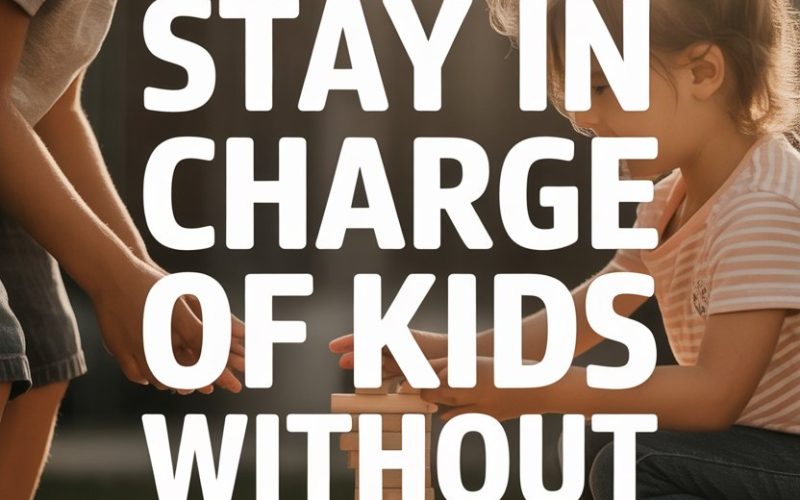Ever find yourself swearing you won’t shout today, only to morph into a foghorn before breakfast? You’re not alone. Life with kids delivers a daily parade of chaos, and nobody hands you a mute button.
But staying in charge without raising your voice? That’s not some mythical feat—it’s absolutely possible, even on four hours’ sleep and no coffee.
Here’s how you can regain authority in your household, protect your vocal cords, and keep your relationship with your kids (mostly) drama-free.
Why Yelling Happens to the Best of Us
Let’s start by chucking the guilt. If you’ve ever lost your cool, welcome to the club—membership includes every parent on the planet and comes with a lifetime supply of regretful late-night overthinking.
The reasons make perfect sense: stress, exhaustion, multitasking, or a child who’s suddenly decided trousers are optional.
Yelling usually pops up when we feel out of control. The problem is, kids don’t hear wisdom through decibels—they hear noise.
And, research published in Child Development suggests that frequent yelling can spark more defiance and anxiety in children, not more compliance.
So, raising your voice? It’s about as effective as trying to mop up a puddle with a slice of bread.
What Staying in Charge Actually Means
Staying in charge isn’t about being a drill sergeant or running your home like a boot camp (unless you fancy yourself in camouflage, in which case, power to you).
It’s about confident, calm authority: setting boundaries, following through, and being the adult your kids feel safe with—even when they’re acting like tiny, unreasonable goblins.
The Magic of the Whisper
Here’s a trick as old as time and twice as sneaky: lower your voice.
Ever noticed how kids snap to attention when you start whispering like you’re sharing a juicy secret? It’s practically sorcery. When you lower your volume, children have to tune in, not tune out.
Whispering can turn a potential shouting match into a moment of curiosity or even connection. Plus, it spares your vocal cords for those passionate karaoke nights.
Get Down on Their Level
Standing over a child and bellowing from the clouds achieves little (other than making you look like a pantomime villain). Kneel, squat, or perch awkwardly—just get your face near theirs.
Eye contact shrinks the emotional distance. It’s a silent message: I see you, I’m listening, and I mean business. Toddlers, tweens, and sullen teens all respond better when you’re physically present, not just a voice booming from above.
Replace “Stop That!” with Specific Instructions
“Stop!” “Don’t!” “No!”—they’re staples, but they’re also about as helpful as a chocolate teapot.
Swap generic commands for clear, actionable instructions. Instead of “Stop hitting your sister!” try “Hands to yourself, please. You can show your sister the toy without touching her.”
Kids (and let’s face it, most grown-ups) process specific expectations much better than vague warnings.
Nonverbal Cues Are Your Secret Weapon
Ever given the look across a crowded room? Parents develop this skill somewhere around the third night of interrupted sleep.
Nonverbal cues—like a stern eyebrow, a finger wag, or the famous crossed arms—can speak volumes. Sometimes the best way to redirect behaviour is by saying nothing at all.
You might be surprised how often it works. And if it doesn’t, at least you’ve perfected your “mum glare” for future use.
Set Boundaries and Actually Stick to Them
Kids are world-class scientists when it comes to testing limits. Announce a new rule, and you’ll get a full battery of experiments before breakfast.
The key: consistency. Wishy-washy boundaries are an open invitation for negotiation. If you say “TV off at 6pm,” but sometimes stretch it because you’re tired, guess what? They’ll push every time.
Being firm, predictable, and boringly consistent is the quickest route to less drama.
Give Choices Instead of Ultimatums
Nobody—child or adult—likes being bossed around. Instead of barking, “Put your shoes on NOW,” try, “Would you like to wear your red trainers or the blue ones today?”
Suddenly, your little rebel feels empowered, and you still get shoes on feet. Choices give children a sense of control, which lowers resistance and reduces the urge to battle for power.
Catch Them Being Good
Ever noticed how swiftly you notice a mess, but not always the quiet moments when your child does the right thing?
Positive reinforcement is a classic for a reason. Instead of only correcting the negative, notice and comment when your child is behaving well: “I love how you’re sitting so patiently,” or “Thank you for using your inside voice.”
This technique, known as ‘catching them being good’, isn’t just warm and fuzzy—it’s backed by experts for building better behaviour, self-esteem, and even stronger parent-child bonds.
Leave the Room (If You Have To)
Some days, your nerves are as frayed as a toddler’s blanket. If you feel that familiar yell rising in your throat, it’s absolutely fine to step away.
Announce, “I need a minute to calm down,” and take a short break. Not only does this help you regain composure, but it also models healthy emotional regulation for your child.
And, if nothing else, it gives you 90 seconds of blessed silence to plot your next move.
Use Natural Consequences
Forget complicated charts and sticker systems if that’s not your thing. Sometimes the best lesson comes from the world itself.
If a child refuses to put on a coat, they might feel cold (and learn quickly for next time). If they ignore a warning not to leave toys out, and the toy gets temporarily confiscated after a stubbed toe, they remember.
This approach, supported by child psychologists, shifts responsibility to your child and teaches real-life cause and effect—without the shouting.
Connect Before You Correct
Trying to get a child’s attention mid-tantrum or while they’re absorbed in a TV show? You’re basically talking to a houseplant.
Call their name, touch their shoulder, or wait for eye contact before giving instructions. Connection is the magic key—children are far more likely to listen (and comply) when they feel seen and heard.
Plus, you’ll avoid that “Didn’t you hear me the first forty times?” routine.
Rethink Your Triggers
Yelling rarely appears out of nowhere. Maybe it’s the morning rush, or mess, or the endless chorus of “Why?” one too many times.
Identifying your trigger points can save the day. Perhaps you need to build in an extra ten minutes before school, or maybe breakfast needs to be less ambitious (toast trumps tears any day).
If you know what sets you off, you can plan around it, or at least warn your family: “Mum’s patience is on special offer until 8am only.”
Team Up with Your Partner or Support Crew
No one should have to parent solo unless they actually want to, and even then, it pays to have backup.
If you’re co-parenting, sync up on rules and responses. Consistency between adults cuts down on confusion and power plays.
If you’re flying solo, lean into your support network—whether it’s family, friends, or that one neighbour who’s always up for a cuppa and a chat about unruly toddlers. You’re not meant to go it alone.
Use Humour to Change the Mood
Ever turned into a robot, a dinosaur, or an over-the-top queen issuing royal decrees just to get your kids moving? Humour can hit the reset button on tension faster than you can say, “Who can hop like a frog to the bathroom?”
Silliness breaks the cycle, lightens the mood, and gets everyone back on side. Plus, it’s near impossible to yell when you’re busy pretending to be a penguin.
Routines Are Your Safety Net
Kids thrive on predictability, even if they claim otherwise. Knowing what happens next gives them a sense of security—and gives you fewer opportunities to lose it.
Charts, songs, or even silly hand signals for routines (like “jammies, teeth, story, bed!”) can keep everyone on track. When kids know what’s expected, you spend less time issuing reminders and more time trying to keep a straight face during “just one more story.”
Repair and Move Forward
If you do yell, all is not lost. Apologise, explain, and move on: “I shouldn’t have shouted. I was frustrated and tired, but that’s not your fault.”
Kids need to know grown-ups mess up too—and that relationships can be repaired. This teaches resilience, forgiveness, and the very human skill of saying sorry.
For the Frazzled: A Little Self-Compassion
No parent is perfect. You will shout, mutter, or even lock yourself in the bathroom now and again. What matters is the big picture: do your kids feel loved, heard, and safe (most of the time)? Then you’re doing brilliantly.
Self-care isn’t just bubble baths and scented candles (though never say no to those).
Sometimes it’s as simple as asking for help, putting the phone down, or making time for something that makes you laugh. Happy-ish parents raise happier kids.
Staying Sane, Staying in Charge
There’s no trophy for never yelling—just the quiet satisfaction that comes from feeling more in control and less like you’re starring in a one-person soap opera.
Try a new approach today: whisper instead of shout, offer a choice, or just take a breath and let the moment pass.
You’ll find your home feels calmer, your relationship with your child stronger, and your voice… well, saved for more important things. Like singing at the top of your lungs in the car with your kids—on key or not.
Now off you go. You’ve got this. And if all else fails, there’s always tomorrow (and that secret chocolate stash in the cupboard).





